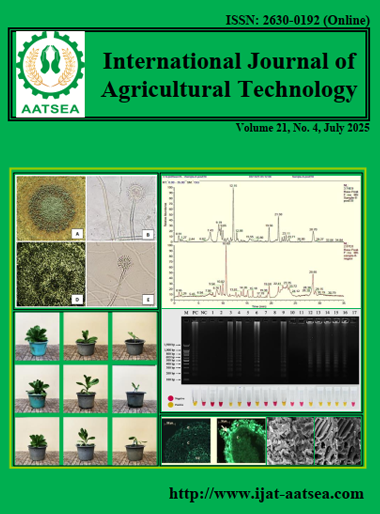Comparative impact of drought stress on growth and yield traits of riceberry and KDML105 rice varieties
Main Article Content
Abstract
The impact of drought stress on the growth and yield components of two Thai rice varieties, Riceberry and KDML 105, was investigated under four irrigation levels (1,000, 3,000, 5,000, and 7,000 mL per 10 days). Significant differences were observed between the two varieties across multiple traits. KDML 105 exhibited superior stem height, dry matter accumulation, and grain production, particularly under high water availability. In contrast, Riceberry produced a greater number of tillers per hill and retained higher soil moisture under limited irrigation, indicating improved water use efficiency (WUE). While KDML 105 achieved optimal grain production and seed weight at 7,000 mL, Riceberry demonstrated superior adaptability to water-limited conditions, due to its compact morphology and effective water retention. These findings suggested that KDML 105 is better suited for water-abundant environments, whereas Riceberry is a promising variety for drought-prone areas requiring water-saving cultivation practices.
Article Details

This work is licensed under a Creative Commons Attribution-NonCommercial-NoDerivatives 4.0 International License.
References
Bouman, B. A. M. and Tuong, T. P. (2001). Field water management to save water and increase its productivity in irrigated lowland rice. Agricultural Water Management, 49:11-30. DOI: https://doi.org/10.1016/S0378-3774(00)00128-1
Bouman, B. A. M., Peng, S., Castaneda, A. R. and Visperas, R. M. (2007). Yield and water use of irrigated tropical aerobic rice systems. Agricultural Water Management, 74:87-105. DOI: https://doi.org/10.1016/j.agwat.2004.11.007
Chaves, M. M., Flexas, J. and Pinheiro, C. (2011). Photosynthesis under drought and salt stress: Regulation mechanisms from whole plant to cell. Annals of Botany, 103:551-560. DOI: https://doi.org/10.1093/aob/mcn125
Concenço, G., Correia, N. M., Crusciol, C. A. C., Silva, A. F., Alves, P. L. C. A., Trezzi, M. M., Vidal, R. A. and Andrade, J. F. (2018). Rice yield components under water stress imposed at different growth stages. Journal of Agricultural Science, 10:281-292. DOI: https://doi.org/10.5539/jas.v10n3p290
Dingkuhn, M., Johnson, D. E., Sow, A. and Audebert, A. Y. (1999). Relationships between upland rice canopy characteristics and weed competitiveness. Field Crops Research, 61:79-95. DOI: https://doi.org/10.1016/S0378-4290(98)00152-X
Farooq, M., Wahid, A., Kobayashi, N., Fujita, D. and Basra, S. M. A. (2009). Plant drought stress: effects, mechanisms and management. Agronomy for Sustainable Development, 29:185-212. DOI: https://doi.org/10.1051/agro:2008021
FAO (2019). The State of Food and Agriculture 2019: Moving forward on food loss and waste reduction. Food and Agriculture Organization of the United Nations, Rome.
Kamoshita, A., Babu, R. C., Boopathi, N. M. and Fukai, S. (2004). Phenotypic and genotypic analysis of drought-resistance traits for development of rice cultivars adapted to rainfed environments. Field Crops Research, 89:1-13.
Kamoshita, A., Wade, L. J., Ali, M. L., Pathan, M. S., Zhang, J., Sarkarung, S. and Nguyen, H. T. (2009). Mapping physiological traits that contribute to tolerance of water deficit in rice. Field Crops Research, 64:143-152.
Kato, Y., Okami, M. and Tajima, R. (2018). Yield potential and water use efficiency of aerobic rice (Oryza sativa L.) in Japan. Field Crops Research, 219:76-82.
Lafitte, H. R. and Courtois, B. (2002). Interpreting cultivar × environment interactions for grain yield in rainfed lowland rice. Agronomy Journal, 94:909-919.
Liu, H., Hussain, S., Zheng, M., Peng, S., Huang, J., Cui, K. and Nie, L. (2020). Dry direct-seeded rice as an alternative to transplanted-flooded rice in Central China. Agronomy Journal, 112:839-851.
Lu, G., Wang, X., Zang, Y., Yang, L. and Zhang, C. (2021). Comparative analysis of tillering dynamics and yield formation in drought-tolerant rice varieties. Plant Physiology and Biochemistry, 160:154-163. DOI: https://doi.org/10.1016/j.plaphy.2021.04.003
Office of Agricultural Economics (2020). Agricultural statistics of Thailand 2020. Ministry of Agriculture and Cooperatives, Bangkok.
Pinkaew, S., Fukuta, Y., Jantaboon, J. and Siangliw, J. L. (2020). Variability of antioxidant activity and health-related compounds in pigmented rice. Agriculture and Natural Resources, 54:221-229.
Sharma, N., Pradhan, A. K., Singh, P. and Dwivedi, D. K. (2017). Impact of canopy characteristics on water use efficiency and crop yield of rice under different irrigation regimes. Journal of Water Management, 35:87-95.
Wassmann, R., Jagadish, S. V. K., Sumfleth, K., Pathak, H., Howell, G., Ismail, A., Serraj, R., Redona, E., Singh, R.K. and Heuer, S. (2009). Regional vulnerability of climate change impacts on Asian rice production and scope for adaptation. Advances in Agronomy, 102:91-133. DOI: https://doi.org/10.1016/S0065-2113(09)01003-7
Xie, H., Li, J., Ren, T. and Luo, X. (2018). The impacts of leaf morphology on transpiration and photosynthesis in rice (Oryza sativa L.). Plant Growth Regulation, 85:259-267.


